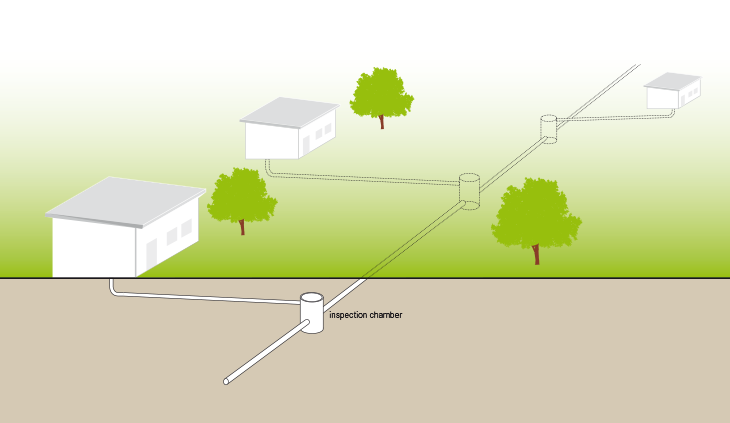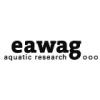 |
This is a water-based system that requires a Urine-Diverting Flush Toilet (UDFT) and a sewer. The Urine-Diverting Flush Toilet (UDFT) is a special User Interface that allows for the separate collection of Urine without water, although it uses water to flush Faeces. Inputs to the system can include Faeces, Urine, Flushwater, Anal Cleansing Water, Dry Cleansing Materials, Greywater and possibly Stormwater.
The main User Interface technology for this system is the Urine-Diverting Flush Toilet (UDFT). A Urinal can be an additional installation for the effective collection of Urine. Brownwater and Urine are separated at the User Interface. Brownwater bypasses a Collection and Storage/Treatment technology and is conveyed directly to a (Semi-) Centralized Treatment facility using a Simplified Sewer or a Conventional Gravity Sewer network. Greywater is also transported in the sewer and is not separately treated.
Stormwater could also be put into the Gravity Sewer network, although this would dilute the wastewater and require Stormwater overflows. Therefore, local retention and infiltration of Stormwater or a separate drainage system for rainwater are the recommended approaches.
Urine diverted at the User Interface is collected in a Urine Storage Tank / Container. Stored Urine can be handled easily and with little risk because it is nearly sterile. With its high nutrient content it can be used as a good liquid fertilizer. Stored Urine can be transported for Application in agriculture (Application of Stored Urine) either using Jerrycan / Tank, or a Motorised Emptying and Transport – the same way that bulk water or Sludge is transported to fields.
Brownwater is treated at a (Semi-) Centralized Treatment facility using a combination of the technologies Settler, Imhoff Tank, Anaerobic Baffled Reactor (ABR), Anaerobic Filter, Waste Stabilization Ponds (WSP), Aerated Pond, Free-Water Surface Constructed Wetland, Horizontal Subsurface Flow Constructed Wetland, Vertical Flow Constructed Wetland, Trickling Filter, Upflow Anaerobic Sludge Blanket Reactor (UASB), Activated Sludge. The Sludge generated from these technologies must be further treated in a dedicated Sludge treatment facility (Sedimentation/ Thickening Ponds, Unplanted Drying Beds, Planted Drying Beds, Co-Composting, Biogas Reactor) prior to Use and/or Disposal. Options for the Use and/or Disposal of the treated Effluent include Irrigation, Fish Pond (Aquaculture), Floating Plant Pond or discharge to a water body (Water Disposal / Groundwater Recharge). After adequate treatment, Sludge can either be used in agriculture (Application of Sludge) or brought to a Storage/Disposal site (Surface Disposal and Storage).
Considerations
This system is only appropriate when there is a need for the separated Urine and/or when there is a desire to limit water consumption by using a low-flush Urine-Diverting Flush Toilet (UDFT) (although the system still requires a constant source of water). There may also be benefits to the treatment plant if it is normally overloaded; the reduced nutrient load (by removing the Urine) could optimize treatment. However, if the plant is currently underloaded (i.e., it has been overdesigned), then this system could further aggravate the problem. Depending on the type of sewers used, this system can be adapted for both dense urban and peri-urban areas. It is not well-suited to rural areas with low housing densities. Since the sewer network is (ideally) watertight, it is also applicable for areas with high groundwater tables.
Dry Cleansing Materials can be handled by the system or they can be collected and separately disposed of (e.g., Surface Disposal and Storage).
Urine-Diverting Flush Toilet (UDFT)s are not common and the capital cost for this system can be very high. This is partly due to the fact that there is limited competition in the User Interface market and also because high quality workmanship is required for the dual plumbing system. Conventional Gravity Sewer require extensive excavation and installation which is expensive, whereas Simplified Sewer are generally less expensive if the site conditions permit a condominial design. Users may be required to pay user fees for the system and its maintenance. Depending on the sewer type and management structure (Simplified vs. Conventional, city-run vs. community-operated, Urine transport and Application) there will be varying degrees of operation or maintenance responsibilities for the homeowner.
This system is most appropriate when there is a high willingness and ability to pay for the capital investment and maintenance costs and where there is a pre-existing treatment facility that has the capacity to accept additional flow.
Guidelines for the Safe Use of Urine and Faeces in Ecological Sanitation Systems have been published by the World Health Organization (WHO) and are referenced on the relevant technology information sheets.
Compendium of Sanitation Systems and Technologies. 2nd Revised Edition
This compendium gives a systematic overview on different sanitation systems and technologies and describes a wide range of available low-cost sanitation technologies.
TILLEY, E., ULRICH L., LÜTHI, C., REYMOND P. and ZURBRÜGG C. (2014): Compendium of Sanitation Systems and Technologies. 2nd Revised Edition. Duebendorf, Switzerland: Swiss Federal Institute of Aquatic Science and Technology (Eawag) URL [Accessed: 03.05.2023] PDFCompendium of Sanitation Systems and Technologies (Arabic)
This is the Arabic version of the Compendium of Sanitation Systems and Technologies. The Compendium gives a systematic overview on different sanitation systems and technologies and describes a wide range of available low-cost sanitation technologies.
TILLEY, E. ULRICH, L. LUETHI, C. REYMOND, P. SCHERTENLEIB, R. ZURBRUEGG, C. (2014): Compendium of Sanitation Systems and Technologies (Arabic). 2nd Revised Edition. Duebendorf, Switzerland: Swiss Federal Institute of Aquatic Science and Technology (Eawag) PDF

